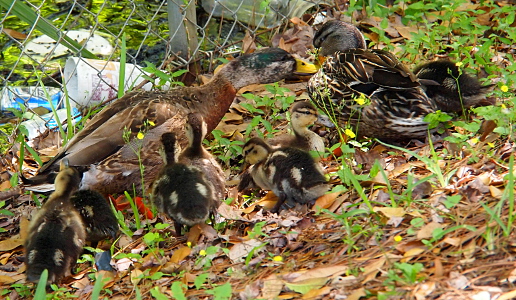While mallard ducks may all pretty much look the same, they do have unique personalities. These pages describe five family stories of ones which frequented the area around an extended-stay hotel in Jacksonville, Florida in 2014 and 2015. The subsequent page describes the difference between momma mallards and the last page highlights the body features of mallards.
This page describes a 2014 family raised by dad. From what I've read it's believed the mother raises the ducklings while the father heads off looking for more fun. (They are not believed to be monogomous like geese are.) For this family and the next, the father stayed near the little ones until the flight feathers began showing. That turned out to be a very good thing for the ducklings on this page.
Page 1 of 7
- - - - - - - - - - - - -
Follow Mom! She took them all through the area while Dad just watched from afar at the top of the hill. The ducklings are about two weeks old at this point.
![[Mom swims away from the camera with four ducklings in a row in the water behind her and a fifth just at the edge of the water and the last two in a line down the hillside following the others.]](Photo-mallards/0409 - ducky08.jpg)
Most of the ducklings are watching the "parental discussion". Neither duck seemed very happy.

This was the last time I saw the momma with her seven ducklings. They're just over 3 weeks old. She's the tall head in the middle. I'm guessing she became a parking lot casualty.
![[Several brown blobs with necks stand in the middle of a grassy area with a bush off to the left side. I shot this with my cellphone so the image is small.]](Photo-mallards/0423 - mallard family of 7 (mom 1) 2.jpg)
The very next morning Dad gave the signal for the little ones to get moving to hide and no one moved until he jumped in the middle with a little physical encouragement.
(Look for the green and yellow in the middle to see his head.)
![[Ducklings in the middle and Dad are slightly blurry from the movement as they scatter in multiple directions across the shallow stream.]](Photo-mallards/0424 - mallard family of 7 (dad 1) 1.jpg)
I'm guessing he witnessed whatever happened to his mate because he was sure keeping an eye on me. He had the ducklings among the tall grasses at this point.
![[Close-up side view of a male mallard in partial eclipse plumage (only the cap of the head is teal colored) staring at the camera while it stood in the middle of the water .]](Photo-mallards/0424 - mallard family of 7 (dad 1) 9.jpg)
I shot the prior photos from the top of the hillside so mallards must have good eyesight. Dad is the dark dot in the middle of the water in the center of the image.
![[Image of a stormwater drainage ditch with at least 10 foot high grassy hillsides on either side of the water meandering through the middle. The mallard is so far away in the image it literally is just a dark dot in the middle of the water. In the background are cars atop the bridge over the drainage area.]](Photo-mallards/0424 - mallard family of 7 (dad 1) 11.jpg)
A family that stays together remains alive, especially when snoozing. Although he didn't lead them around like mother mallards do, Dad kept them in sight. He never let them get more than about 50 yards from him and was at the top of the hill when I shot this.
![[The seven ducklings are wing to wing as they huddle together in the brown grass (blend in quite well!). At least one has its eyes closed.]](Photo-mallards/0429 - mallard family of 7 (dad1) 4.jpg)
By this image the ducklings were about six weeks old. While they were still super-glued to each other, I no longer saw Dad nearby. The very beginnings of their flight feathers have started at this point.
![[The seven large ducklings are huddled together near the water's edge as they nap.]](Photo-mallards/0509 - mallard family of 7 12.jpg)
The family that eats together stays together? They've only begun to start growing flight feathers so I'm sure there's safety in numbers at this point.
![[The seven large ducklings are in the water and all have their heads at least partially submerged at the same time as they eat.]](Photo-mallards/0509 - mallard family of 7 26.jpg)
Over time I started seeing a group of six in the area on a regular basis. Since no mallard momma had six I think something happened to one of the original seven. By this image approximately five weeks later they have their blue flight feathers. While I knew some were males based on their bill color, their feathers do not change to mature male colors until much later their first year.
![[Six mallards stand in a grouping in the grass. The speculum feather (purple-blue rimmed in white) are visible.]](Photo-mallards/0615 - mallard family of 7maybe 13.jpg)
They are now fliers.
![[One mallard just went off the edge of the pavement and has its wings partially spread in flight.]](Photo-mallards/0607 - mallard family of 7maybe 6.jpg)
Continue to page 2 to see the family of 9.
All photos © S. M. Garver